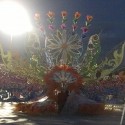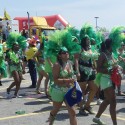The Science of Caribana

Vishnu Ramcharan is in charge of special projects, visitor and community engagement at the Ontario Science Centre
By Stephanie Pollard
“We are not apart from the community, we are a part of the community,” says Vishnu Ramcharan about the Ontario Science Centre and the neighbourhood in which it is housed. “So, it’s not us and Flemingdon, we are Flemingdon.” For him, and those who visit the massive building at 770 Don Mills Rd., the Science Centre is all about sharing a learning experience. Until August, people are getting to experience the science behind the art of Caribana.
Since its beginning in 1967, this celebration of Caribbean culture has lived through the arts — visual, culinary, literary and musical aspects of the festival were what attracted tourists en masse and preserved the cultures of thousands of Toronto’s immigrants.
Now, for the second year in a row, the Science Centre is peering into the scientific aspect of the festival and knocking down stereotypes as it goes. “Yup, there’s jerk chicken and dancing. Yes, there’s roti. But there’s also a nation of people who’ve adapted to the environment and, from what they were given, created a world that did not exist before. That is Caribbean culture,” says Ramcharan, who is in charge of special projects, visitor and community engagement at the Ontario Science Centre.
In fact, the Caribbean is a living example of cultural mix-up. Each island, though similar in origin through slavery, has distinct cultures blended with African, European, Asian, South Asian and even cultures belonging to the Amerindians. The islands have been practicing diversity since long before Canada decided to take it on as a trademark. That means Ramcharan, who is originally from Trinidad and Tobago, is perfect for the job, “I can look at them and say, ‘I’m from the Caribbean — been there done that!’”
But what scientific aspects of Caribana do people get to see, exactly? Well, first, the Electronic Pan, or e-pan for short, is on display. Invented by Salmon Cupid, a Toronto-based, Trinidad-born innovator, it is the world’s first electronic synthesized steel pan. As part of the e-pan exhibit, visitors are challenged to transform an ordinary item into a musical instrument for the 22nd century.
“At one point, this [type of steel pan] was unheard of,” explains Ramcharan, “So, participants go back to that point where they rediscover the skills, attitudes and behaviours of innovating.” Costume making, next to music, is the most vital part of Caribana. So, the Science Centre is also serving as a kids’ carnival, where children use K’NEX pieces to create moving costumed beings. Also, as a first for the Science Centre and Caribana, the festival will reward the most innovative costume. “We’re going to get input from the band leaders as to what they consider the most innovative,” says Ramcharan. “For instance, any material or technology that has never been used before or something that’s made to inspire people [will be recognized].”
The ultimate goal for this Caribana experience is to have people learn through hands-on participation as opposed to the usual spectatorship. Ramcharan hopes that with this, and the many other cultural experiences offered at the Ontario Science Centre, visitors both from Toronto and around the world will understand diversity at its finest. “The stuff that we can learn from people, it belongs to all of us. If you’re open to it, that’s who it belongs to.”






[...] year, Caribana spotlights the steel pan, particularly with the Pan Alive competition. However, Cupid believes that [...]
Leave your response!